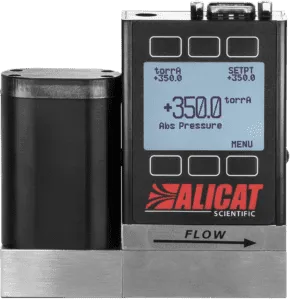Increasing vacuum deposition speed and stability with upstream pressure control
Upstream pressure control provides numerous benefits to vacuum deposition setups. Regulating pressure upstream of the vacuum chamber eliminates the need for additional valves, reducing equipment costs and minimizing potential leak points. A fast-acting, proportional control valve additionally improves deposition speed and stability.
Challenge: Traditional downstream pressure setups are slow, expensive, and can be a hassle to upgrade
Vacuum deposition setups traditionally use downstream pressure control, which is problematic for a few reasons. These setups:
- Utilize expensive throttle valves
- Experience delays when changing gas flows or while waiting for the gas in the chamber to settle
- Require a separate control module to power the valve, provide PID data, and control the setpoint of the pressure controller
Upgrading systems is also problematic, as legacy equipment can be a pain to replace. It is optimal to upgrade systems with equipment that can easily be dropped in without the need for a major system redesign.
Solution: Minimize pressure fluctuations using easy-to-integrate upstream pressure controllers
The PC-EXTSEN pressure controller is designed to smoothly integrate into your existing system without requiring any other design changes. This device is mounted upstream of the vacuum chamber and uses an external sensor, such as the existing vacuum gauge, to control vacuum levels. The pressure controller can additionally be standardized on and connected to a common control interface, using serial or analog communications, or an industrial protocol such as EtherCAT.
The Alicat pressure controller maintains the chamber pressure precisely at the desired level.
Rapid response times as fast as 30 ms and a high repeatability of up to ±0.08% of full scale together prevent disturbances to the system pressure and result in highly consistent vacuum coatings.
Eliminate the throttle valve bulk using IVC-Series integrated vacuum controllers
Using this external pressure sensor in conjunction with the vacuum gauge allows you to most accurately maintain the vacuum chamber pressure, even while changing or adjusting the gases being flowed in. This allows for faster application of neutral gases and overall improved system control via the steady pressure levels in the coating environment.
For setups without an existing vacuum gauge, the IVC-Series pressure controllers eliminate the need for a gauge. The IVC-Series directly integrates a high-accuracy vacuum sensor for reliable control as low as 0.01 milliTorr. Similarly to the PC-EXTSEN, this device is able to cut out the bulk, complication, and expense of a traditional throttle valve pressure control method.
These pressure controllers can also be configured with a pneumatically isolated sensor, which can be plumbed directly into your vacuum chamber. This sensor allows for precision measurement of the vacuum chamber regardless of the composition of the flowing gas.
IVC-Series pressure controller with integrated vacuum sensor
Conclusion
Alicat applications engineers will always recommend upstream pressure control for thin film deposition applications. Depending on the parameters of your setup and whether you are looking to design with or without an external vacuum gauge, either a PC-EXTSEN or an IVC-Series pressure controller may be advantageous.
Pressure controllers with external sensors are able to integrate gauge signals directly while providing upstream control. Pressure controllers with integrated vacuum sensors are simple solutions, requiring less equipment in a setup.
In either case, placing pressure control devices upstream of the chamber in vacuum coating applications saves time and cost, and increases accuracy in vacuum deposition tools.

